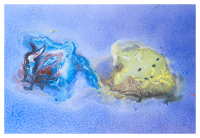Speaker
David Edwin Alvarez Castillo
(JINR)
Description
In order to prove the existence of a critical end point (CEP) in the
QCD phase diagram it is sufficient to demonstrate that at zero
temperature $T=0$ a first order phase transition exists as a function
of the baryochemical potential $\mu$, since it is established
knowledge from ab-initio lattice QCD simulations that at $\mu=0$ the
transition on the temperature axis is a crossover.
We present the argument that the observation of a gap in the
mass-radius relationship for compact stars which proves the existence
of a so-called third family (aka "mass twins") will imply
that the $T=0$ equation of state of compact star matter exhibits a
strong first order transition with a latent heat that satisfies
$\Delta\epsilon/\epsilon_c >0.6$ [Alford et al., arxiv:1302.4732].
Since such a strong first order transition under compact
star conditions will remain first order when going to symmetric matter, the observation of a disconnected
branch (third family) of compact stars in the mass-radius diagram proves the existence of a CEP in QCD.
Modelling of such compact star twins in realistic models based on a QCD motivated nonlocal PNJL model with density-dependent vector
coupling strength will be presented here.
Furthermore we show results of a Bayesian analysis (BA) using disjunct M-R constraints for
extracting probability measures for cold, dense matter equations of state. In particular this study reveals
that measuring radii of the neutron star twins has the potential to
support the existence of a first order phase transition for compact star matter.
Author
David Edwin Alvarez Castillo
(JINR)
Co-author
David Blaschke
(University of Wroclaw)
